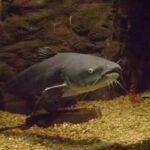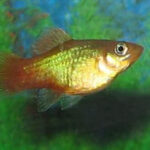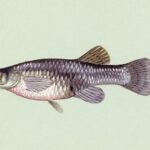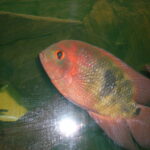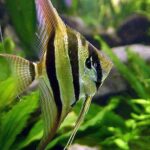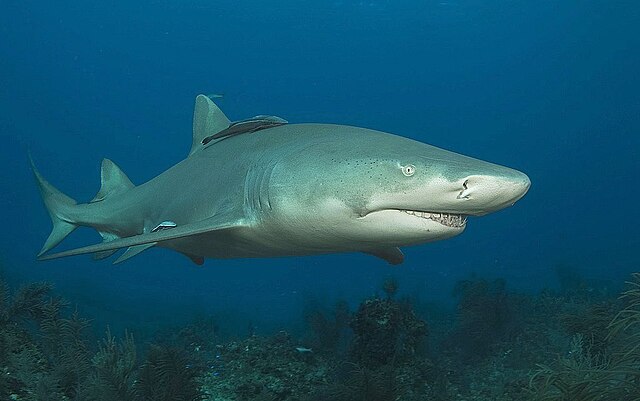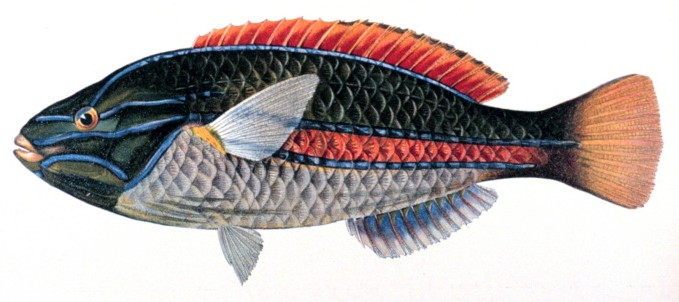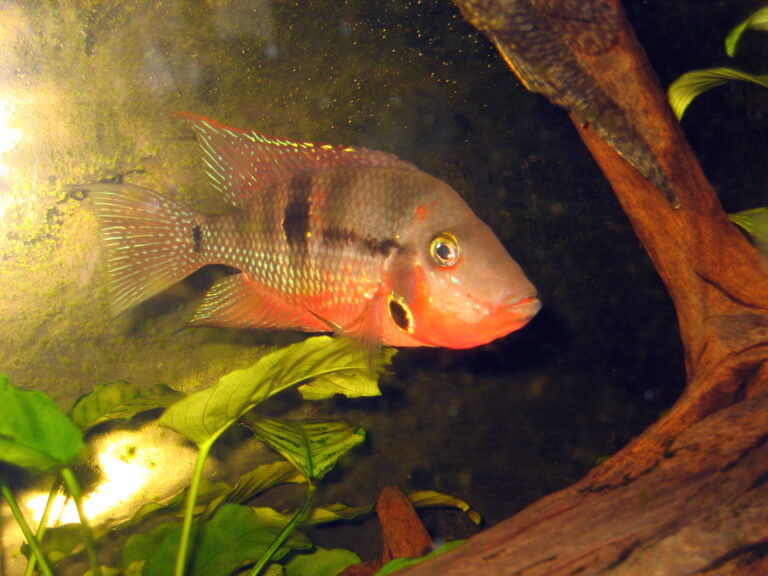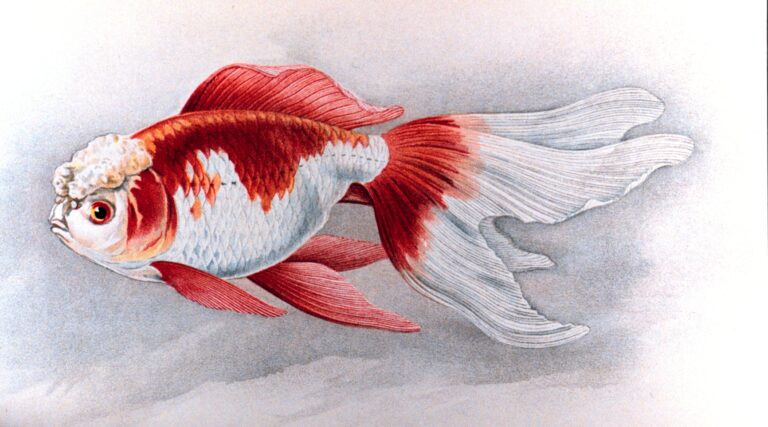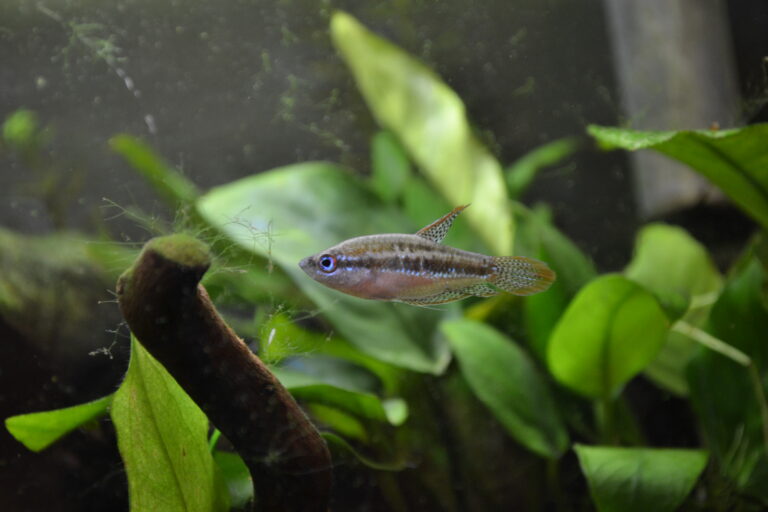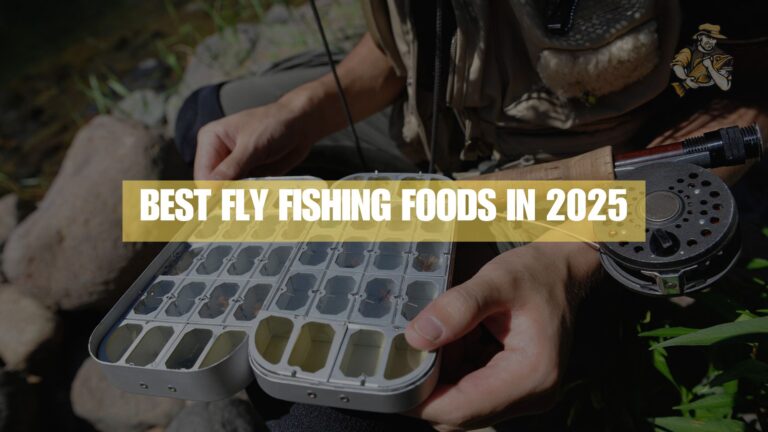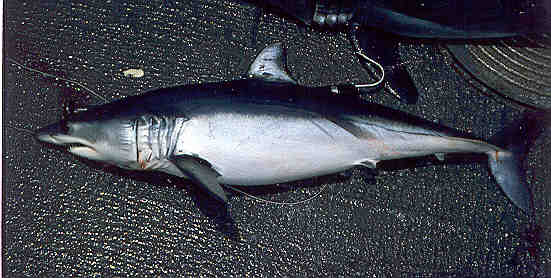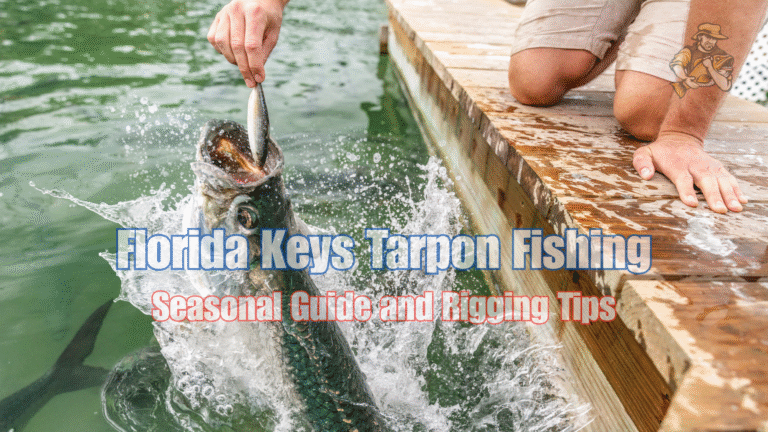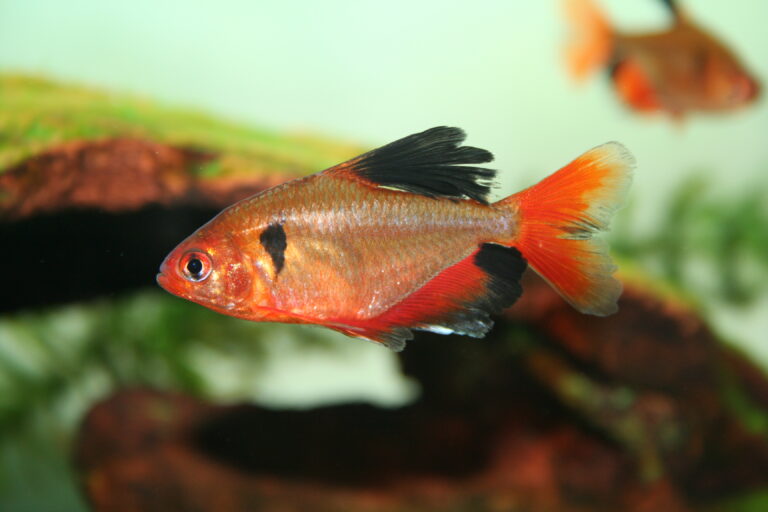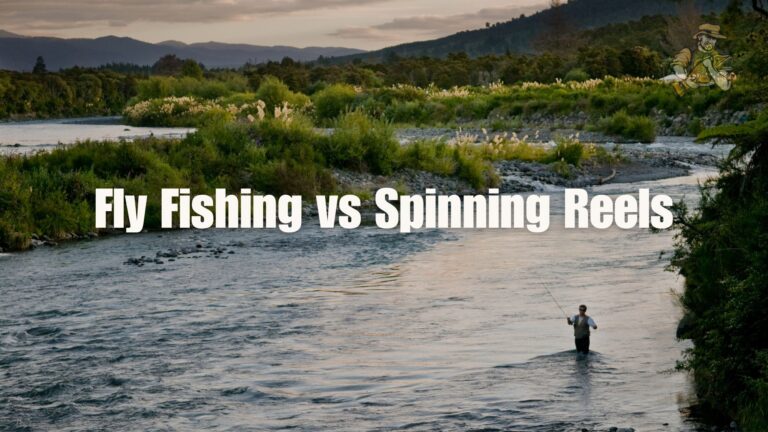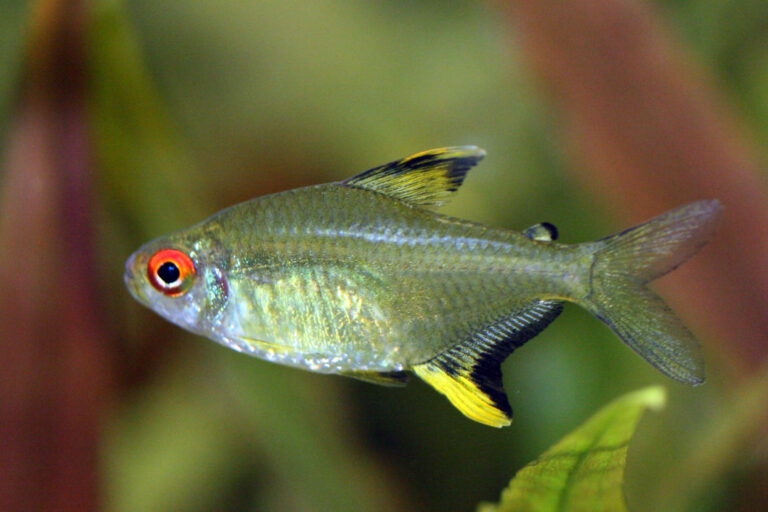Pineapple Swordtail
By Ryan Maron | Last Modified: June 11, 2025

The Pineapple Swordtail (*Xiphophorus hellerii* var. pineapple) represents one of the most striking color variants of the common swordtail, distinguished by its vibrant yellow-orange coloration and distinctive black-edged scales that create a pineapple-like pattern. This freshwater livebearing fish has become a cornerstone species in the aquarium trade, prized for its hardy nature, peaceful temperament, and spectacular breeding displays. Beyond their ornamental value, Pineapple Swordtails serve crucial ecological roles in their native Central American watersheds as both predators of aquatic invertebrates and prey for larger fish species. Their adaptability to various water conditions and prolific breeding habits have made them essential indicators of ecosystem health in tropical freshwater environments.
| Feature | Details |
|---|---|
| Common Name | Pineapple Swordtail |
| Scientific Name | Xiphophorus hellerii var. pineapple |
| Family | Poeciliidae |
| Typical Size | 10-14 cm (4-5.5 inches), 15-30 grams |
| Habitat | Tropical freshwater streams and rivers |
| Diet | Omnivorous – insects, algae, small crustaceans |
| Distribution | Central America, widely introduced globally |
| Conservation Status | Least Concern |
Taxonomy & Classification
The Pineapple Swordtail belongs to the family Poeciliidae, which encompasses over 200 species of livebearing freshwater fish. Within the genus *Xiphophorus*, the species *hellerii* was first described by German ichthyologist Heckel in 1848, with the pineapple variety representing a selectively bred color morph developed through decades of aquaculture efforts. The genus name *Xiphophorus* derives from the Greek words “xiphos” meaning sword and “phoros” meaning bearer, directly referencing the elongated lower caudal fin extension characteristic of males.
Genetic studies have revealed that the distinctive pineapple coloration results from a combination of xanthophore concentration and melanophore distribution patterns controlled by multiple allelic genes. This complex inheritance pattern explains why breeding two Pineapple Swordtails does not guarantee offspring with identical coloration intensity or pattern uniformity.
The Poeciliidae family shares common ancestry with killifish and demonstrates remarkable evolutionary adaptability to diverse freshwater environments. Molecular phylogenetic analysis places *X. hellerii* within a clade of approximately 26 recognized *Xiphophorus* species, many of which exhibit natural hybridization capabilities that have contributed to the development of numerous aquarium varieties.
Physical Description
Male Pineapple Swordtails exhibit the characteristic elongated sword-like extension of the lower caudal fin ray, typically measuring 2-4 centimeters in length when fully developed. The body displays a brilliant golden-yellow to orange base coloration with distinctive black-edged scales creating a crosshatch pattern reminiscent of pineapple skin texture. This pattern intensity varies significantly among individuals, with some specimens showing subtle scale outlining while others display bold, contrasting black markings.
Females lack the sword extension but maintain the vibrant pineapple coloration, though typically less intense than their male counterparts. Adult females develop a notably fuller body profile, particularly when gravid, and can reach slightly larger overall body dimensions despite the absence of the caudal sword. The dorsal fin in both sexes shows translucent qualities with occasional orange or yellow tinting along the fin rays.
The species exhibits sexual dimorphism beyond the obvious sword extension, with males developing a modified anal fin called a gonopodium used for internal fertilization. This structure appears as a rod-like projection approximately 8-12 millimeters long in mature males. Eye coloration ranges from bright silver to pale gold, with the iris often reflecting ambient lighting conditions due to specialized iridophore cells.
Juvenile Pineapple Swordtails display muted coloration until sexual maturity, typically developing full adult pigmentation between 4-6 months of age depending on water temperature and nutritional factors. The transformation from juvenile gray-brown tones to adult brilliance occurs gradually over several weeks.
Habitat & Distribution
Native populations of *Xiphophorus hellerii* originally inhabited the Atlantic slope river systems of Central America, ranging from southeastern Mexico through Guatemala and into northern Honduras. These natural watersheds feature warm, moderately alkaline waters with temperatures consistently between 22-28°C and pH levels ranging from 7.0-8.5. The Pineapple Swordtail variety, being a captive-bred strain, has adapted to slightly broader water parameter ranges.
Wild swordtail populations prefer shallow, well-oxygenated areas with moderate current flow and abundant vegetation coverage. They frequent river margins, tributary streams, and natural pools where emergent and submerged plants provide both food sources and protection from predators. Water depth preferences typically range from 30-150 centimeters, allowing easy access to surface insects while maintaining escape routes to deeper refugia.
Human introduction has established Pineapple Swordtail populations across tropical and subtropical regions worldwide, including parts of Florida, Hawaii, Australia, and Southeast Asia. These introduced populations often thrive in similar ecological niches to their native range, demonstrating remarkable environmental plasticity. However, such introductions have raised ecological concerns regarding competition with native fish species.
Seasonal variations significantly influence habitat utilization patterns, with swordtails moving into shallower breeding areas during warmer months and retreating to deeper, more stable waters during cooler periods. This behavioral adaptation reflects their evolutionary development in regions with distinct wet and dry seasonal cycles.
Diet & Feeding Behavior
Pineapple Swordtails demonstrate opportunistic omnivorous feeding strategies, consuming a diverse array of food sources that vary seasonally and by habitat availability. Their natural diet consists primarily of aquatic insects, insect larvae, small crustaceans, algae, and detritus matter found in their freshwater environments. Surface feeding behavior is particularly prominent, with individuals often positioning themselves near the water interface to capture fallen terrestrial insects.
Feeding activity peaks during dawn and dusk periods, corresponding with increased insect activity and optimal light conditions for prey detection. Their upturned mouth structure facilitates efficient surface feeding, while their pharyngeal teeth allow processing of both plant and animal matter. Stomach content analysis reveals that adult swordtails consume approximately 15-25% of their body weight daily during active growing seasons.
Juveniles exhibit more herbivorous tendencies, spending considerable time grazing on algal films and soft plant tissues. This dietary shift supports rapid growth requirements during early development stages. As they mature, protein requirements increase significantly, particularly in breeding females who must support developing embryos.
In aquarium environments, Pineapple Swordtails readily accept commercial flake foods, frozen bloodworms, brine shrimp, and vegetable matter. Their adaptable feeding behavior has contributed significantly to their success as both aquarium specimens and in introduced wild populations where they can exploit diverse food sources.
Behavior & Adaptations
Pineapple Swordtails exhibit complex social behaviors characterized by loose schooling tendencies and hierarchical interactions, particularly among males competing for breeding opportunities. Dominant males establish temporary territories around favorable feeding or breeding sites, displaying to females through fin spreading, color intensification, and ritualized swimming patterns. These territorial displays rarely result in physical aggression, instead relying on visual intimidation and persistence.
Swimming patterns reveal remarkable agility and rapid acceleration capabilities, adaptations essential for evading predators in their natural riverine environments. Their streamlined body shape and powerful caudal fin provide efficient propulsion, while the sword extension in males may serve as a visual distraction mechanism during predator encounters, directing attacks away from vital body regions.
Temperature tolerance represents a crucial adaptation enabling their widespread distribution success. Pineapple Swordtails can survive temperature ranges from 18-32°C, though optimal physiological function occurs between 24-26°C. This thermal flexibility allows colonization of diverse geographic regions and seasonal survival in temperate climates.
Stress response mechanisms include rapid color changes, with vibrant pineapple coloration fading under adverse conditions. This physiological adaptation provides camouflage benefits while indicating overall health status to potential mates and rivals. Recovery of full coloration intensity serves as a reliable indicator of improved environmental conditions and individual fitness.
Reproduction & Life Cycle
Pineapple Swordtails employ internal fertilization through the male’s specialized gonopodium, which transfers sperm packets directly into the female’s reproductive tract. Fertilized females can store viable sperm for multiple reproductive cycles, potentially producing 3-4 broods from a single mating event. This reproductive strategy maximizes breeding efficiency and genetic diversity within populations.
Gestation periods typically last 24-30 days depending on water temperature, with warmer conditions accelerating embryonic development. Gravid females display characteristic darkening of the gravid spot near the anal region and increased abdominal distension as birth approaches. Brood sizes range from 20-80 fry, with larger, older females generally producing more offspring per reproductive cycle.
Birth occurs through live delivery of fully formed, free-swimming juveniles measuring approximately 6-8 millimeters in length. Unlike many fish species, swordtail fry require no parental care and immediately begin independent feeding on microscopic organisms and algae. This reproductive independence contributes significantly to their population establishment success in new environments.
Sexual maturity occurs between 3-5 months of age, with environmental factors such as temperature, nutrition, and population density significantly influencing development rates. Males typically develop their characteristic sword extension shortly after reaching sexual maturity, with full sword development continuing for several additional weeks. Breeding activity peaks during warmer months when food availability and optimal water conditions coincide.
Predators & Threats
Natural predators of Pineapple Swordtails include larger fish species such as bass, pike, and predatory catfish that share their freshwater habitats. Avian predators including herons, kingfishers, and cormorants pose significant threats, particularly to individuals feeding near the water surface. The bright coloration of Pineapple Swordtails, while attractive to aquarists, can make them more visible to visual predators compared to their naturally colored counterparts.
Juvenile mortality rates remain high due to predation pressure from both fish and invertebrate predators such as dragonfly larvae, water beetles, and crayfish. The small size and limited escape capabilities of young fry make them particularly vulnerable during their first few weeks of life. Dense vegetation coverage provides crucial refugia that significantly improve juvenile survival rates.
Environmental threats include water pollution, habitat modification, and climate change impacts on their preferred temperature ranges. Agricultural runoff containing pesticides and fertilizers can severely impact population health through direct toxicity and ecosystem disruption. Urban development near waterways often results in habitat fragmentation and altered flow patterns that reduce suitable breeding and feeding areas.
In introduced populations, Pineapple Swordtails face additional challenges from native predators that may not have evolved alongside similar prey species. However, their reproductive resilience and behavioral adaptability often enable population recovery following predation pressure or environmental disturbances.
Conservation Status
The International Union for Conservation of Nature (IUCN) classifies *Xiphophorus hellerii* as Least Concern due to stable wild populations throughout their native range and successful establishment in numerous introduced locations worldwide. However, this classification primarily reflects the parent species rather than specific color varieties like the Pineapple Swordtail, which exists almost exclusively in captive-bred populations.
Native habitat preservation remains important for maintaining genetic diversity within wild swordtail populations that serve as breeding stock for aquarium varieties. Central American watershed conservation efforts focus on reducing agricultural pollution and maintaining riparian vegetation corridors that support diverse freshwater fish communities including swordtails.
The aquarium trade has created economic incentives for continued breeding programs that maintain Pineapple Swordtail populations, though this captive focus raises questions about genetic bottlenecks and long-term viability. Responsible breeding practices emphasize maintaining genetic diversity through outcrossing with other swordtail varieties and careful selection protocols.
Climate change projections suggest that warming temperatures may expand suitable habitat ranges for swordtails in some regions while creating thermal stress in others. Monitoring programs track population responses to environmental changes and provide early warning systems for conservation intervention needs.
Human Interaction
The aquarium trade represents the primary human interaction with Pineapple Swordtails, with millions of specimens produced annually through commercial breeding operations worldwide. Their hardy nature, attractive appearance, and peaceful temperament have made them among the most popular freshwater aquarium fish for both beginning and experienced aquarists. Breeding programs focus on maintaining color intensity while improving disease resistance and overall vigor.
Educational institutions frequently utilize swordtail fish varieties in biological studies examining genetics, reproduction, and behavior due to their rapid breeding cycles and observable characteristics. Research applications include investigations into color inheritance patterns, social behavior dynamics, and environmental adaptation mechanisms.
Commercial aquaculture operations have developed specialized techniques for mass production of Pineapple Swordtails, including selective breeding protocols, optimal nutrition formulations, and disease prevention strategies. These advances have significantly reduced production costs while improving fish quality and survival rates during shipping and retail phases.
Some regions have implemented regulations regarding swordtail introductions to prevent ecological disruptions in native fish communities. Florida, for example, monitors established populations and evaluates their impacts on indigenous species. Such regulatory approaches balance commercial interests with environmental protection concerns.
Interesting Facts
Male Pineapple Swordtails can transform into functional females under specific environmental conditions, a phenomenon known as sequential hermaphroditism that occurs when population demographics become heavily skewed toward males. This remarkable adaptation ensures reproductive continuity even when normal breeding ratios are disrupted.
The sword extension in males continues growing throughout their lifetime, with some exceptional specimens developing swords nearly equal to their body length. However, excessively long swords can impair swimming efficiency and make individuals more vulnerable to predation due to reduced maneuverability.
Pineapple Swordtails demonstrate remarkable memory capabilities, recognizing individual tank mates and learning complex feeding schedules in aquarium environments. Studies have documented recognition periods lasting several weeks, suggesting sophisticated cognitive abilities often underestimated in small freshwater fish species.
Their ability to leap from water surfaces serves as both an escape mechanism and feeding strategy for catching low-flying insects. This behavior requires careful aquarium management with secure covers to prevent accidental escapes. Some wild populations have been observed jumping obstacles up to 15 centimeters high during upstream migrations.
The intensity of pineapple coloration can be influenced by diet, with carotenoid-rich foods enhancing yellow and orange pigmentation. This dietary relationship explains why wild specimens often display more muted colors compared to aquarium-raised individuals fed specialized color-enhancing foods.
Frequently Asked Questions
How long do Pineapple Swordtails typically live?
Pineapple Swordtails generally live 3-5 years in optimal aquarium conditions, with some exceptional individuals reaching 6-7 years. Lifespan depends significantly on water quality, diet, temperature stability, and genetic factors. Wild populations may experience shorter lifespans due to predation pressure and environmental stresses.
Can Pineapple Swordtails breed with other swordtail varieties?
Yes, Pineapple Swordtails readily interbreed with other swordtail varieties and closely related species like platies. Hybrid offspring often display intermediate characteristics and may exhibit unique color patterns. However, excessive hybridization can dilute the distinctive pineapple coloration in subsequent generations.
What water conditions do Pineapple Swordtails prefer?
Optimal conditions include temperatures between 24-26°C, pH levels of 7.0-8.0, and moderate water hardness of 10-25 dGH. They tolerate slight variations but perform best in stable, well-filtered water with regular partial changes. Good oxygenation and gentle current flow replicate their natural riverine habitat preferences.
Are Pineapple Swordtails suitable for community aquariums?
Pineapple Swordtails make excellent community fish due to their peaceful nature and adaptability. They coexist well with similar-sized species like platy fish varieties, tetras, and corydoras catfish. However, avoid housing them with aggressive species or fin-nippers that might damage the male’s sword extension.
Conclusion
The Pineapple Swordtail stands as a testament to successful selective breeding while maintaining the hardy characteristics that have made swordtails popular for over a century. Their ecological adaptability, striking appearance, and reproductive resilience ensure continued importance in both aquarium hobby and educational applications. As responsible stewards, maintaining genetic diversity and supporting conservation of their native habitats remains essential for preserving these remarkable freshwater gems for future generations.
Share The Article:
More Fish Species:
-
Pearl Gourami
The Pearl Gourami stands as one of the most recognizable and ecologically significant members of the labyrinth fish family,…
-
Lemon Shark
The Lemon Shark (*Negaprion brevirostris*) represents one of the most scientifically studied and ecologically significant predators in coastal marine…
-
Rainbowfish
Rainbowfish represent one of the most visually striking and ecologically significant groups of freshwater fish found across Australia, New…
-
Firemouth Cichlid
The Firemouth Cichlid (*Thorichthys meeki*) stands as one of Central America’s most recognizable freshwater fish species, distinguished by its…
-
Oranda Goldfish
The Oranda Goldfish (Carassius auratus) stands as one of the most distinctive and cherished varieties in the world of…
-
Sparkling Gourami
The Sparkling Gourami represents one of the most captivating miniature freshwater species available to aquarium enthusiasts and serves as…
Discover
-
7 Best Fly Fishing Foods That Trout Can’t Resist in 2025
If there’s one thing I’ve learned after three decades of fly fishing, it’s that trout can be maddeningly selective…
-
Shortfin Mako Shark
The Shortfin Mako Shark stands as one of the ocean’s most remarkable predators, combining exceptional speed with sophisticated hunting…
-
Florida Keys Tarpon Fishing: Seasonal Guide and Rigging Tips
I still remember my first tarpon hookup in the Florida Keys like it happened yesterday, not 17 years ago….
-
Atlantic Salmon: Ultimate Guide for Anglers in 2025
For as long as I can remember, I’ve been captivated by Atlantic salmon fishing. There’s something almost mystical about…
-
North Jersey Fishing Guide: Best Lakes, Rivers & Seasons
If you’ve never experienced the fishing in North Jersey, you’re missing out on some genuinely underrated angling opportunities. From…
-
Spinner Shark
The Spinner Shark (Carcharhinus brevipinna) stands as one of the ocean’s most distinctive and acrobatic predators, earning its name…
Discover
-
How to Fish with Dry Flies: Beginner’s Guide to Surface Action
There’s something almost magical about watching a trout rise to sip your dry fly from the surface. I still…
-
Serpae Tetra
The Serpae Tetra (Hyphessobrycon eques) stands as one of South America’s most recognizable freshwater aquarium species, distinguished by its…
-
Colorful Tetra Fish Types Every Aquarium Owner Should Know
When I set up my first freshwater aquarium years ago, tetras quickly became my go-to fish. These colorful little…
-
Fly Fishing vs Spinning Reels: Choosing the Right Technique
If there’s one debate that never seems to end in fishing circles, it’s fly fishing versus spinning gear. I’ve…
-
Lemon Tetra
The Lemon Tetra (*Hyphessobrycon pulchripinnis*) stands as one of South America’s most vibrant freshwater fish species, distinguished by its…
-
Pelagic Thresher Shark
The Pelagic Thresher Shark stands as one of the ocean’s most distinctive and efficient predators, renowned for its dramatically…

